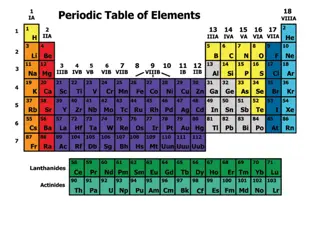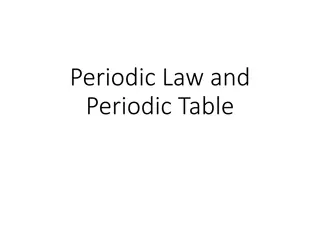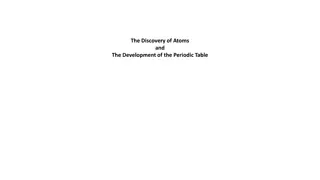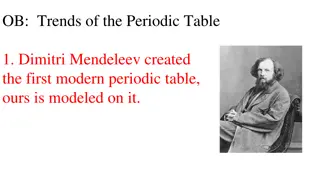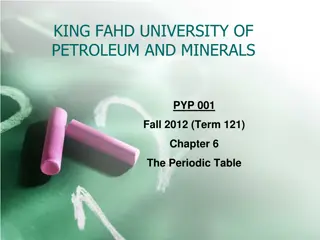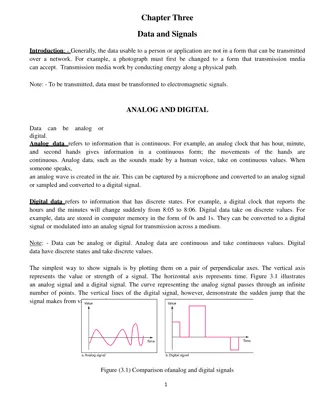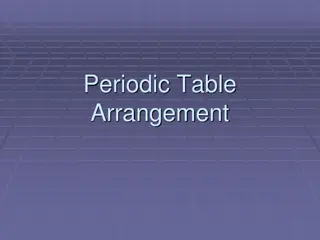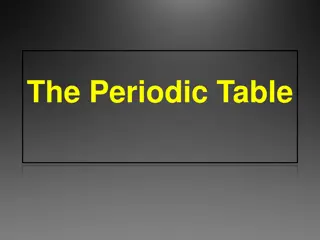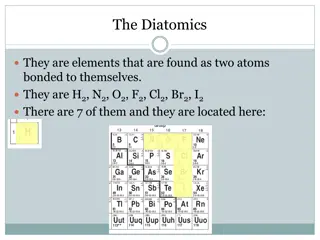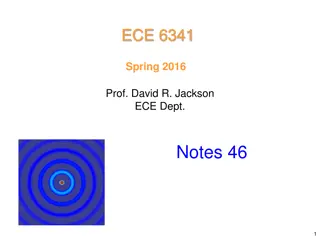Evolution of the Periodic Table: From Dobereiner to Mendeleev
The evolution of the periodic table, from Dobereiner's Law of Triads to Newlands' Law of Octave, and finally Mendeleev's Periodic Law and Original Periodic Table, marked significant strides in organizing chemical elements based on their properties and atomic weights. Each contribution led to the refinement and development of the periodic table as we know it today.
Download Presentation

Please find below an Image/Link to download the presentation.
The content on the website is provided AS IS for your information and personal use only. It may not be sold, licensed, or shared on other websites without obtaining consent from the author. Download presentation by click this link. If you encounter any issues during the download, it is possible that the publisher has removed the file from their server.
E N D
Presentation Transcript
Periodic Table Course Instructor: Dr. Atul Kumar Singh Assistant Professor Department of Chemistry M. L. Arya College, Kasba Purnia -854330 India
INTRODUCTION According to Huxley, The actual or ideal arrangement together of those which are alike and separation of those which are unlike; the purpose of this arrangement being primarily to disclose the correlations, or laws of union, or properties, or circumstances and secondarily to facilitate the operation of the mind in dearly receiving and then retaining in the memory the characteristics of the objects in question."
Brief Historical Development of the Periodic Table 1. Dobereiner's Law of Triads In between 1817 and 1829, Dobereiner gave law of triads. According to which in certain triads the atomic mass of the middle element was approximately equal to thee arithmetic mean of the atomic masses of the other two elements and the chemical properties of the middle element were in between triads of the end members.
The main drawback of this classification was that the concept was applicable to only to a limited number of elements not all the known elements.
2. Newlands Law of Octave In 1865, Newlands gave the law of octave. According to this law, if the elements are arranged in order of their increasing atomic weight, the. Physical and chemical properties of the elements repeat after interval of seven elements like 8th note of the musical. Scale.
The system worked quite well for the lighter elements but fails in the case of heavier elements
MENDELEEV'S PERIODIC LAW AND ORIGINAL PERIODIC TABLE In 1869, a Russian scientist Mendeleev gave the periodic law. According to this law, When elements are arranged in the order of increasing atomic weight, elements with similar properties appear at regular intervals. The physical and chemical properties of elements are periodic functions of their atomic weight
The main points of periodic law as stated by Mendeleev are below: 1. The elements, if arranged according to their atomic weights exhibit an evident periodicity of properties. 2. Elements which are similar as regards their chemical properties have atomic weights which either are of nearly same value, e.g., Fe, Co, Ni or increase regularly, e.g., K, Rb, Cs. Mendeleev, D.I. 1889. The Periodic Law of the Chemical Elements. Journal of the Chemical Society 55: 634-656.
3. The arrangement of elements/or groups of elements in the order of their atomic weights corresponds to their so called "valencies" as well as their distinctive properties. 4. The elements which are most widely distributed in nature have small atomic weights and possess sharply defined properties. 5. The magnitude of atomic weight determines the character of the element. Mendeleev, D.I. 1889. The Periodic Law of the Chemical Elements. Journal of the Chemical Society 55: 634-656.
6. Many yet unknown elements may be discovered. 7. The atomic weight of an element may sometimes be corrected with the aid of the knowledge of the atomic weights of the adjacent elements. 8. Certain characteristic properties of elements can be foretold from their atomic weights. Mendeleev, D.I. 1889. The Periodic Law of the Chemical Elements. Journal of the Chemical Society 55: 634-656.
Modern Periodic Law In 1912, a British Physicist Henery Moseley discovered new property of element called atomic number and stated that the properties of elements are periodic functions of their atomic numbers.
Modern periodic table Nine vertical columns: groups Seven horizontal rows: periods Devided in to 4 Blocks s Block: receive the last electron in the s orbital p Block: receive the last electron in the p orbital d Block: receive the last electron in the d orbital f -Block: receive the last electron in the f orbital



